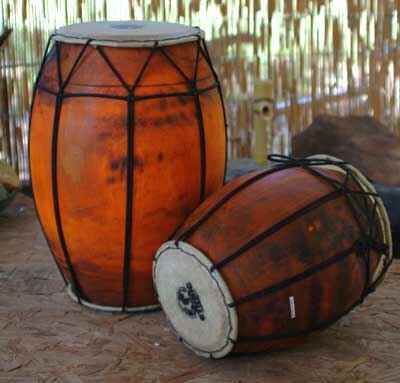 Ramwong
Drums Ramwong
Drums
2003 - In our never ending search for lightweight portable
percussion instruments, we came across these Ramwong drums
in the Meinl Catalog. No one was rushing to the store for these
little babies, since the world at large knew very little about them.
We searched the Web, & found nothing, other than that they are
used in Thai Ramwong music, of which we could find no decent examples
(none with a drum part audible, anyway).
Still, with well sewn calf and thick bulbous solid wood shells,
they are brimming with potential, so what the heck...we bought some.
Both drums together were less than $100, and they are very very
portable. We began to experiment.
So far we like playing them with one hand and one stick.
They are not unlike the Ghanian barrel drums, similar to the drums
used in Candombe, but with solid shells, and smaller. The shells
are quite thick, and the response is good to anything from a chopstick
to a clave.
To give you an idea of what these Ramwong sound like, we recorded
a rhythm we named Bongogo, based on an ostinado
by the lowest Ramwong. For this recording, we used a clave, with
one big and two small Ramwong parts, one on each end. This gave
us the three distinct voices. We used a $30 LabTec Microphone from
the computer store, and recorded right into our standard sound card..
Listen to the Ramwong - Bongogo.mp3
x = stick on the wood rim
o = stick on the open head
L = left hand touches the head, stopping it from ringing
it would be easy to further develop this rhythm by exploring the
possibility of having a smaller drum do the ostinado as the bigger
one improvises. We could even design a series of signals designed
to pass the ostinado back and forth amongst the three players. When
that is recorded, we will post it.
big ramwong part:
o.Lx.oo. o.Lx.oo. o.Loo.Lo
o.Lx.oo.
small ramwong bigger
head part: improvised, loosely based on
x.oo.xx. x.oo.xx. or
x.oo.x.x x.oo.x.x
small ramwong smaller
head part: improvised loosely around
x..x.x.x x.o.oo..
(these open tones inspired the name: "bon-gogo"
then as the rhtyhm thickens
and begins to cook:
x.x.oo.x x.x.oo.x or
x...oo.x .oo.oo..
|

